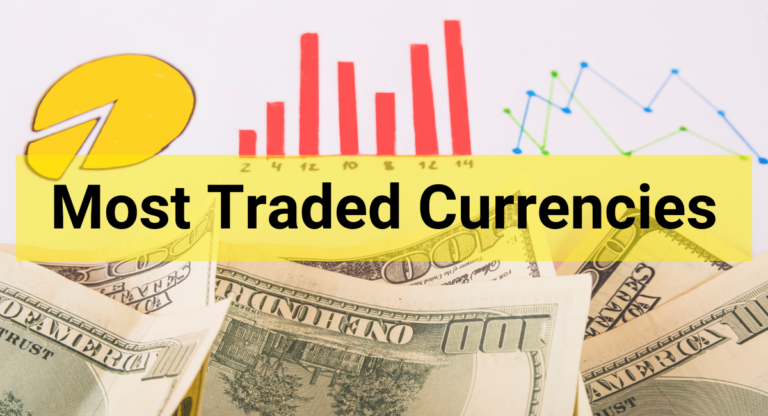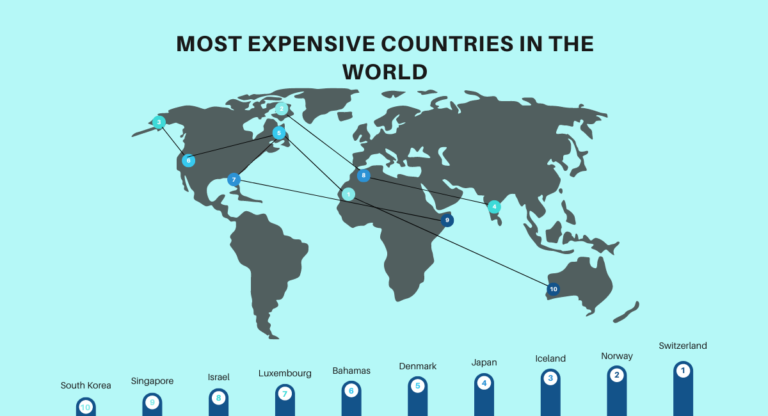A Look at the Strongest Currencies in the World
Many factors contribute to a currency’s strength. A nation’s robust economy, rich natural resources, and political stability all play a role. Strong currencies allow countries to import more goods without breaking the bank, and their citizens enjoy greater purchasing power internationally.
So, who are these financial VIPs? Let’s explore the Strongest Currencies In The World.
List of the Strongest Currencies in the World
The following is the list of the Strongest Currencies In The World.
- Kuwaiti Dinar
- Bahraini Dinar
- Omani Rial
- Jordanian Dinar
- British Pound Sterling
- Cayman Islands Dollar
- Euro
- Swiss Franc
- US Dollar
- Bahamian Dollar
1. Kuwaiti Dinar
The Kuwaiti Dinar (KWD) reigns supreme as the world’s most valuable currency, with one dinar fetching around 3.27 US dollars (as of December 2023). This oil-rich nation’s currency boasts a fascinating history and unique characteristics.
Born in 1961, the dinar replaced the Gulf rupee, severing ties with its colonial past. Initially, it was pegged to the British pound, but now it enjoys a stable exchange rate thanks to a basket of undisclosed currencies. This basket likely includes major players like the US dollar and Euro.
Nicknamed Fils, 1,000 of these smaller units make up one dinar. Interestingly, Kuwaiti banknotes are known for their security features and beautiful designs. The front showcases iconic buildings, while the back tells the story of Kuwait’s achievements and economic milestones. These notes even cater to the visually impaired with raised print and larger denominations.
Kuwait’s strong economy, fueled by its vast oil reserves, is a major reason behind the dinar’s high value. The country’s wealth is reflected in its currency, making it a symbol of stability and prosperity.
Also read: 10 Richest Countries In Asia
2. Bahraini Dinar
The Bahraini Dinar (BHD), a strong contender for the title of most valuable currency, sits comfortably at number two on the global stage. Clocking in at roughly 2.66 US dollars (as of December 2023), this currency boasts a rich history and interesting quirks.
Debuting in 1965, the dinar replaced the Gulf rupee, marking a new chapter in Bahrain’s financial system. Interestingly, it was initially pegged to the British pound, but in 1971, it found a more stable partner – the US dollar. This peg remains in place today, ensuring a predictable exchange rate for Bahrain’s businesses and citizens.
Divided into 1,000 fils, the dinar comes in a variety of colorful banknotes. Issued by the Central Bank of Bahrain, these notes showcase the nation’s culture and heritage. From majestic mosques to bustling marketplaces, the designs offer a glimpse into Bahrain’s vibrant identity.
Unlike some other currencies, the smaller fils coins are rarely used in everyday transactions. Instead, handy ½ and 1 dinar coins handle most purchases.
The strength of the Bahraini dinar is closely linked to Bahrain’s economy, which relies heavily on oil and gas exports. This resource wealth translates into a stable and valuable currency, a symbol of Bahrain’s economic strength on the world stage.
3. Omani Rial
Occupying the third place on the podium of the world’s most valuable currencies is the Omani Rial (OMR). While not the absolute champion, it holds its ground as a symbol of Oman’s economic strength. As of June 4, 2024, a single Omani Rial fetched a cool 0.38 US dollars, making it quite valuable compared to many other currencies.
The Omani Rial’s story began in 1970, a time of change for Oman. It replaced the Gulf rupee, marking a significant step towards financial independence. Interestingly, its initial peg was to the British pound, reflecting historical ties. However, today, the Omani Rial enjoys a more stable relationship with a basket of undisclosed currencies, likely including major players like the US dollar and the Euro. This basket approach helps shield the Omani Rial from fluctuations in any single currency.
Just like its valuable counterparts, the Omani Rial is divided into smaller units. Here, 1,000 baisa make up one rial. But the Omani Rial isn’t just about numbers – its banknotes are known for their beauty and security features. The fronts showcase the architectural wonders of Oman, while the backs tell the story of the nation’s achievements and economic milestones. These notes are even designed with accessibility in mind, incorporating raised print for visually impaired users.
The strength of the Omani Rial is deeply rooted in Oman’s economy, heavily reliant on its oil reserves. This resource wealth translates into a stable and valuable currency, a symbol of Oman’s prosperity on the world stage.
4. Jordanian Dinar
Nestled amidst the historical treasures of the Middle East, the Jordanian Dinar (JOD) reigns as the official currency of Jordan. While not the most valuable globally, it holds a position of strength within the region.
Debuting in 1950, the dinar replaced the Palestinian pound, marking a turning point for Jordan’s financial system. Unlike some neighbors who rely on a basket of currencies, the Jordanian Dinar enjoys a special partnership – it’s pegged to the US dollar. This creates a predictable exchange rate, fostering a business-friendly environment and stability for Jordanian citizens.
One Jordanian Dinar is divided into 100 qirsh (also called piastres), further divisible into 1,000 fils. Though fils are rarely used nowadays, Jordanian currency maintains a three-decimal place system reflecting their historical significance. Jordanian banknotes are renowned for their artistry and security features
The strength of the Jordanian Dinar is intricately linked to Jordan’s economy. While not solely reliant on oil reserves like some of its neighbors, Jordan boasts a diversified economy with strong tourism and trade sectors. This economic strength translates into a stable and valuable currency, a symbol of Jordan’s resilience and prosperity.
5. British Pound Sterling
The British Pound Sterling (GBP), with a history as rich as the tea it’s often used to buy, is the world’s oldest currency still in use.
The Pound Sterling’s origins can be traced back to Anglo-Saxon times, making it a true veteran on the global financial scene. Its name itself comes from the Latin word “libra,” meaning “pound,” referring to a specific weight of silver.
Before 1971, the Pound had a complex division system. It was divided into 20 shillings, and each shilling further into 12 pence. So, 3 shillings and 6 pence would be written as “3/6” and spoken as “three and sixpence.” This system may sound strange today, but it was the norm for centuries.
In 1971, the Pound Sterling underwent a decimalization process, similar to many other currencies. This simplified things considerably, making 100 pence equal to one pound. Today, British wallets hold coins in denominations of 1p, 2p, 5p, 10p, 20p, 50p, £1, and £2. Banknotes come in crisp denominations of £5, £10, £20, and £50.
The Pound Sterling remains a major player in the foreign exchange market, ranking fourth behind the US dollar, Euro, and Japanese yen. Its stability and long history make it a trusted currency for international transactions.
Represented by the symbol £ or ₤ (a stylized letter L), the Pound Sterling boasts advanced security features on its banknotes. These features include raised printing for visually impaired users and holograms to deter counterfeiting.
6. Cayman Islands Dollar
Island vibes meet financial stability with the Cayman Islands Dollar (KYD), the official currency of this tropical paradise. While not as widely known as some global giants, the KYD boasts a unique story and interesting characteristics.
Born in 1972, the KYD replaced the Jamaican dollar, marking a new chapter for the Cayman Islands’ financial independence. Interestingly, both currencies co-existed for a short period before the KYD took the sole spotlight.
The Cayman Islands Dollar is intricately linked to its big neighbor, the US dollar. Unlike some currencies that float freely, the KYD is pegged to the US dollar at a fixed rate: CI$1 equals US$1.20. This peg offers stability for businesses and residents, making it easy to calculate conversions.
KYD coins come in denominations of 1 cent, 5 cents, 10 cents, and 25 cents. These colorful coins often feature playful designs like dolphins and sea turtles, reflecting the island’s marine life. The banknotes, on the other hand, showcase a more regal side.
Each note prominently features a portrait of Queen Elizabeth II, a nod to the Cayman Islands’ status as a British Overseas Territory. Security features like watermarks and colorful threading ensure the authenticity of these notes.
The Cayman Islands’ thriving tourism industry makes the US dollar widely accepted alongside the KYD. However, using KYD allows visitors to experience a bit of local culture. The strength of the KYD is also tied to the Cayman Islands’ role as a major offshore financial center. This strong financial sector contributes to the currency’s stability.
Also explore: 12 Oldest Cities in the US
7. Euro
The Euro (€) isn’t just a currency; it’s a symbol of unity. Born in 1999, it replaced the individual currencies of 12 European nations, fostering economic integration across the continent.
The Euro’s strength lies in its collective power. It’s the second-most traded currency globally, right behind the US dollar. This widespread use makes it a stable and reliable option for international transactions.
Euro coins come in denominations of 1, 2, 5, 10, 20, and 50 cents, and €1 and €2. Interestingly, the reverse side of each coin features a common design – a map of Europe. The obverse side, however, allows each country to showcase its national symbol or monument. This balance between unity and national pride is a core theme of the Euro.
Euro banknotes come in denominations of €5, €10, €20, €50, €100, €200, and €500. Unlike coins, banknotes have a uniform design across all participating countries. The design features bridges and windows in various architectural styles, symbolizing the connections and openness within the Eurozone. Security features are top-notch, with watermarks, holograms, and raised printing deterring counterfeiting.
While a resounding success, the Euro is still evolving. New member countries are periodically added, and ongoing economic discussions aim to further strengthen the currency’s stability.
8. Swiss Franc
Nestled amidst the snow-capped peaks of Switzerland lies the Swiss Franc (CHF), a currency renowned for its stability and strength.
The Franc’s journey began in 1850, replacing a variety of cantonal currencies and promoting national unity. Unlike some currencies that float freely, the Swiss Franc is managed by the Swiss National Bank. This careful management has earned it a reputation as a haven currency, a reliable option during times of economic turmoil.
One Swiss Franc is divided into 100 Rappen (Rp.), though coins in denominations less than 5 Rp. are rarely used anymore. Swiss coins are known for their artistry, featuring iconic landmarks like the Matterhorn and the Rütli meadow, a symbol of Swiss independence.
Swiss Franc banknotes are a marvel of security. They boast advanced features like watermarks, raised printing, and micro printing that changes color when tilted. These features make counterfeiting extremely difficult and contribute to the Franc’s reputation as a reliable currency. Additionally, the design of the notes showcases famous Swiss figures like architects and scientists, celebrating the nation’s rich history and innovation.
Switzerland’s long history of neutrality plays a key role in the Franc’s strength. Being politically and militarily neutral allows Switzerland to maintain a stable economy, which in turn strengthens the Franc’s value. Additionally, strong banking regulations and a robust financial sector contribute to the Franc’s trustworthiness.
9. US Dollar
The US Dollar (USD), with its iconic green face and symbol ($), is a global powerhouse. It’s not just the currency of the United States, but also the world’s leading reserve currency, meaning many countries hold large amounts of it for international transactions.
The US Dollar’s journey began in 1792, replacing a variety of colonial currencies. Its name reflects the nation’s desire for a standardized unit of money, unlike the “dollars” used by Spain and other European countries.
US coins come in denominations of 1 cent (penny), 5 cents (nickel), 10 cents (dime), 25 cents (quarter), 50 cents (half dollar), and $1 (dollar coin). These coins often feature iconic symbols like the Statue of Liberty and the American Eagle.
Paper bills, on the other hand, come in denominations of $1, $5, $10, $20, $50, and $100. Each bill showcases a different US president on the front, with historical buildings and landmarks adorning the back. Security features like watermarks and security threads are cleverly woven into the design to deter counterfeiting.
The US Dollar’s dominance stems from several factors. The large and stable US economy inspires confidence in its currency. Additionally, the vast network of US banks and financial institutions facilitates international trade using USD. It’s also widely accepted by businesses and travelers worldwide.
While the US Dollar remains the top dog, the rise of other currencies and the evolving global financial landscape could challenge its dominance. However, the US Dollar’s strong foundation and long history suggest it will continue to be a major player in the global financial arena for years to come.
Also see: 10 Most Rich States in the USA
10. Bahamian Dollar
Anchoring the beautiful Bahamas archipelago is the Bahamian Dollar (BSD), a currency as vibrant as the island chain itself.
Born in 1966, the Bahamian Dollar replaced the Bahamian pound, marking a significant step towards financial independence for the Bahamas. This island nation, known for its turquoise waters and white sand beaches, found its monetary voice with the Bahamian Dollar.
The Bahamian Dollar is pegged to the US dollar at a fixed rate: B$1 equals US$1. This peg offers stability for businesses and residents, making budgeting and conversions straightforward. Interestingly, the Bahamian Dollar also features a portrait of Queen Elizabeth II on its higher denomination banknotes, a nod to the Bahamas’ history as a British colony.
Bahamian coins come in denominations of 1 cent, 5 cents, 10 cents, 15 cents, 25 cents, and $1. These colorful coins often showcase the rich marine life of the Bahamas, with playful designs featuring dolphins, turtles, and even the majestic flamingo. The banknotes, on the other hand, depict a mix of historical figures, Bahamian landmarks, and local flora and fauna.
Tourism is a major pillar of the Bahamian economy, and the US dollar is widely accepted alongside the Bahamian Dollar. However, using Bahamian Dollars allows visitors to experience a bit of local culture and support the island nation’s financial system. The stability of the Bahamian Dollar is closely linked to the strength of the US dollar but also benefits from the Bahamas’ thriving tourism industry.
Conclusion
The world of strong currencies is a fascinating one, where stability, economic power, and historical ties intertwine. We’ve explored some of the Strongest Currencies In The World, from the oil-backed giants of the Middle East to the bastions of financial security like Switzerland.
It’s important to remember that currency strength is a dynamic concept. Global events, economic fluctuations, and resource discoveries can all shift the landscape. However, the currencies we’ve discussed have proven their resilience and continue to be major players on the international stage.
FAQs
What Is the Weakest Currency in the World?
The Lebanese Pound (LBP) and Iranian Rial (IRR) are the weakest currencies in the world. Both currencies experience high inflation, meaning prices of goods and services rise quickly, further eroding their buying power.
What Is the Most Secure Currency in the World?
The two top contenders for the most secure currencies in the world are Swiss Franc (CHF) and US Dollar (USD).
What Currency Is Most Universal?
The title of most universally accepted currency goes to the US Dollar (USD).
What Is the Highest Currency in Asia?
The highest-valued currency in Asia is the Kuwaiti Dinar (KWD). It consistently ranks among the strongest currencies globally, not just within Asia.
What Makes a Powerful Currency?
A strong economy, rich natural resources, and a trusted government all contribute to a currency’s power. This makes it valuable for international trade and gives its citizens greater buying power abroad.

I’m Sophia Jones, an adventurer at heart from New York City, USA. I live for travel and exploration, always eager to discover new places, meet fascinating people, and try out diverse cuisines. Over the past few years, I’ve traveled to numerous countries, immersing myself in different cultures and creating unforgettable memories.






